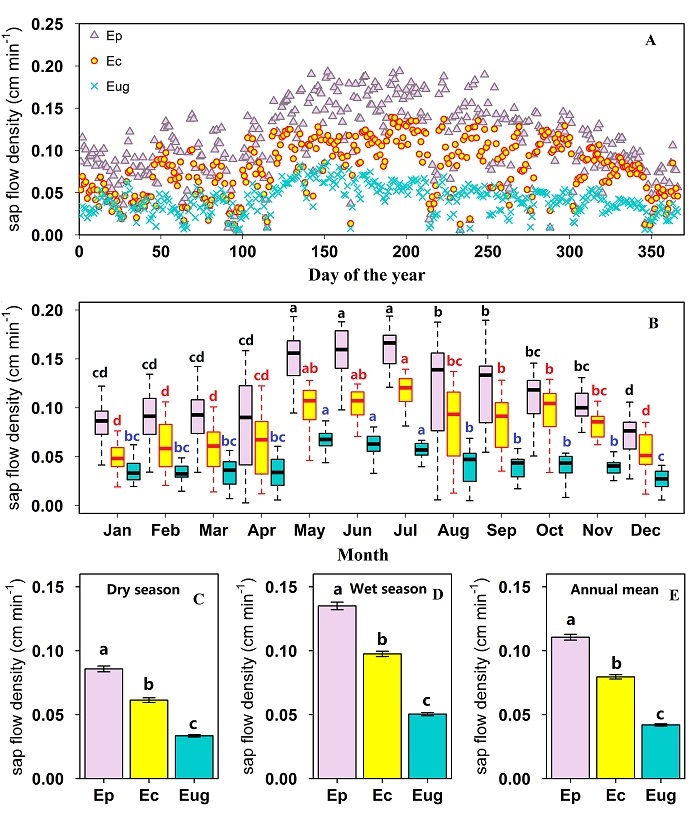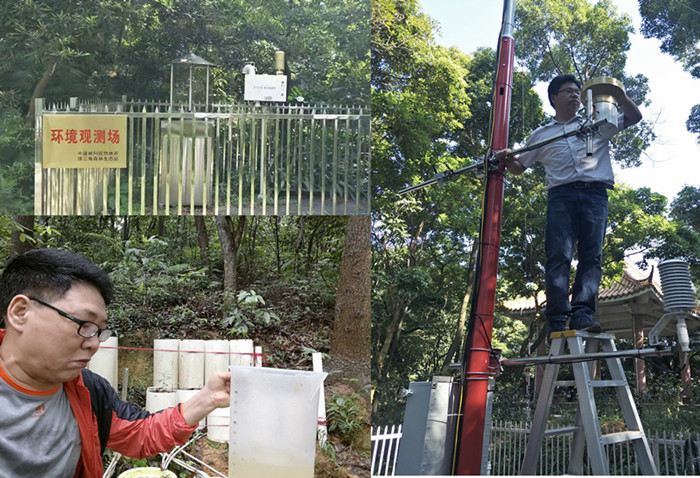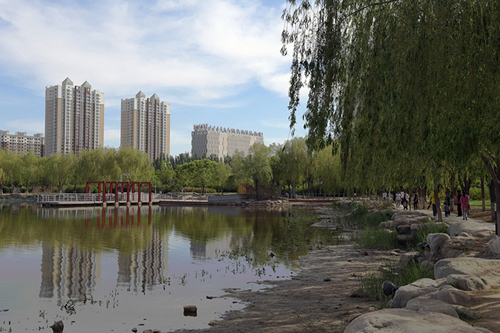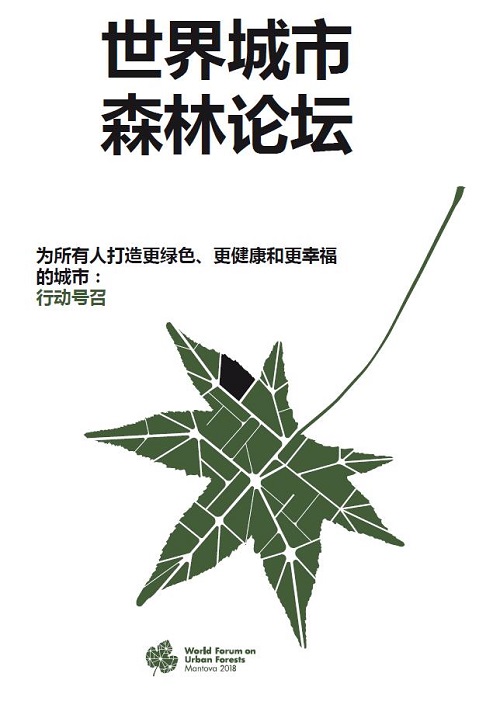
城市森林结构多样性预测冠下地面温度的潜力研究
编号
lyqk011410


中文标题
城市森林结构多样性预测冠下地面温度的潜力研究


作者单位
东北林业大学园林学院 黑龙江省寒区园林植物种质资源开发与景观生态修复重点实验室 哈尔滨 150000


期刊名称
中国城市林业


年份
2024


卷号
22


期号
2


栏目名称
专题1:城市绿地热缓解


中文摘要
城市森林冠层具有调控城市森林微气候的能力,但现有研究尚未阐明冠层结构对冠下地面温度的影响及其预测潜力。文章基于无人机机载激光雷达(UAV-LiDAR)提取哈尔滨林业示范基地的城市森林冠层结构多样性特征指标,探究单一结构多样性特征对冠下地面温度的影响,以及结构多样性多因子组合对温度的预测潜力。结果表明:1)城市森林结构多样性的8个特征因子与冠下地面温度呈显著相关关系(P<0.05),其中深间隙(DG)、深间隙分数(DGF)、覆盖分数(CF)、间隙分数分布(GFP)表征了结构多样性的覆盖/开放度特征;冠层高度标准差(Hstd)、冠层高度最大值(Hmax)、95%分位点高度(ZQ95)表征了高度特征;垂直复杂指数(VCI)表征了异质性特征。2)城市森林冠层结构多样性的覆盖/开放度特征对冠下地面温度的响应更强(R2为0.15~0.5),强于高度指标(R2为0.14~0.19)以及异质性指标(R2=0.14)。3)结合高度指标、覆盖/开放度指标以及异质性指标的多因子预测模型2(R2=0.61,RMSE=0.51,MSE=0.26,AIC=62.74),对于冠下地面温度的预测性能更优。研究明晰了城市森林结构多样性的多因子变量及其特征组合预测冠下地面温度的潜力,为城市森林冠层结构调控内部小气候环境研究提供了科学参考。


关键词
无人机机载激光雷达(UAV-LiDAR)
城市森林
冠层结构多样性
冠下地面温度
预测模型


基金项目
国家自然科学基金面上项目“寒地城市森林水平与垂直结构季相变异的冷岛机制研究”(42171246);中央高校基本科研业务费专项资金项目子课题“寒地城市绿地生态系统智能监测”(2572023CT18-04)


英文标题
Investigating the Potential of Urban Forest Structural Diversity in Predicting Understorey Surface Temperature


作者英文名
Wang Lei, Yao Mingchen, Jia Jia


单位英文名
College of Landscape Architecture/Key Laboratory of Heilongjiang Province for Garden Plant Germplasm Development & Landscape Eco-Restoration in Cold Regions, Northeast Forestry University, Harbin 150000, China


英文摘要
Urban forest canopy has the ability to regulate the microclimate of urban forests, but existing studies have yet clarified the impact of canopy structure on the temperature beneath the canopy and its potential in prediction. This study, based on Unmanned Aerial Vehicle-Light Detection and Ranging (UAV-LiDAR), extracts indices of urban forest canopy structural diversity at the Harbin Forestry Demonstration Base and investigates the impact of individual structural diversity characteristics on the surface temperature beneath the canopy, as well as the potential of a multifactorial combination of structural diversity in temperature prediction. The results show that:1) Eight characteristic factors of urban forest structural diversity are significantly correlated with the temperature beneath the canopy (P<0.05). These characteristics include Deep Gap (DG), Deep Gap Fraction (DGF), Cover Fraction (CF), and Gap Fraction Profile (GFP), which characterize the coverage/openness of structural diversity, while Canopy Height Standard Deviation (Hstd), Maximum Canopy Height (Hmax), and the 95th Percentile Height (ZQ95) represent height characteristics, and the Vertical Complexity Index (VCI) represents the feature of heterogeneity; 2) The coverage/openness of urban forest canopy structural diversity shows a stronger response to the surface temperature beneath the canopy (R2 values range from 0.15 to 0.5), which is higher than the response of height indicators (R2 values range from 0.14 to 0.19) and heterogeneity indicators (R2=0.14); and 3) A multifactorial predictive model2, which combines height indicators, coverage/openness indicators, and heterogeneity indicators (R2=0.61, RMSE=0.51, MSE=0.26, AIC=62.74), demonstrates superior predictive performance for the surface temperature beneath the canopy. This study clarifies the potential of multifactorial variables and their characteristic combinations relevant to urban forest structural diversity in predicting the surface temperature beneath the canopy, providing a scientific reference for the research on urban forest canopies regulating the microclimate.


英文关键词
unmanned aerial vehicle-light detection and ranging (UAV-LiDAR);urban forest;canopy structure diversity;understory surface temperature;prediction model


起始页码
1


截止页码
9


投稿时间
2023/12/27


作者简介
王蕾(1983-),女,博士,教授,博士生导师,研究方向为城市森林及其生态服务功能。E-mail:wanglei@nefu.edu.cn


DOI
10.12169/zgcsly.2023.12.27.0002


参考文献
[1] FEDERICA M,HERIS M P,GRAZIA Z,et al.Urban heat island mitigation by green infrastructure in European Functional Urban Areas[J].Sustainable Cities and Society,2022,77:103564.
[2] PENG W,WANG R,DUAN J,et al.Surface and canopy urban heat islands:does urban morphology result in the spatiotemporal differences?[J].Urban Climate,2022,42:101136.
[3] 李晓婷,李彤,仇宽彪,等.城市森林林木斑块特征与降温效应的关系:以北京市城区为例[J].林业科学,2021,57(4):32-42.
[4] GEORGIANA G, BOGDAN U. Land Use/Land Cover changes dynamics and their effects on Surface Urban Heat Island in Bucharest,Romania[J].International Journal of Applied Earth Observations and Geoinformation,2019,80:115-126.
[5] 刘海轩,许丽娟,吴鞠,等.城市森林降温效应影响因素研究进展[J].林业科学,2019,55(4):144-151.
[6] YAO L,LI T,XU Y.How the landscape features of urban green space impact seasonal land surface temperatures at a city-block-scale:an urban heat island study in Beijing,China[J].Urban Forestry & Urban Greening,2020,52:126704.
[7] TIWARI A,KUMAR P,KALAIARASAN G,et al.The impacts of existing and hypothetical green infrastructure scenarios on urban heat island formation[J].Environmental Pollution,2021,274:115898.
[8] LIU H,CAO F L,SHE G H,et al.Extrapolation assessment for forest structural parameters in planted forests of southern China by UAV-LiDAR Samples and Multispectral Satellite Imagery[J].Remote Sensing,2022,14(11):2677.
[9] LYU R F,PANG J L,TIAN X L,et al.How to optimize the 2D/3D urban thermal environment:Insights derived from UAV LiDAR/multispectral data and multi-source remote sensing data[J].Sustainable Cities and Society,2023,88:104287.
[10] MENGE J H,MAGDON P,WÖLLAUER S,et al.Impacts of forest management on stand and landscape-level microclimate heterogeneity of European beech forests[J].Landscape Ecology,2023,38(4):903-917.
[11] SMITH-TRIPP S M,ESKELSON B N I,COOPS N C,et al.Canopy height impacts on the growing season and monthly microclimate in a burned forest of British Columbia,Canada[J].Agricultural and Forest Meteorology,2022,323:109067.
[12] WU G,YOU Y,YANG Y,et al.UAV-LiDAR measurement of vegetation canopy structure parameters and their impact on land-air exchange simulation based on Noah-MP Model[J].Remote Sensing,2022,14(13):2998.
[13] 丛丹,王蕾,贾佳,等.哈尔滨城市森林景观季节变化对地表温度影响的定量研究[J].中国城市林业,2024,22(1):34-42.
[14] PAN Y D,BIRDSEY R A,PHILLIPS O L,et al.The structure,distribution,and biomass of theworld's forests[J].Annual Review of Ecology,Evolution,and Systematics,2013,44:593-622.
[15] CAO L,LIU H,FU X Y,et al.Comparison of UAV LiDAR and Digital Aerial Photogrammetry Point Clouds for estimating forest structural attributes in subtropical planted forests[J].Forests,2019,10(2):145.
[16] BLANCHARD G,BARBIER N,VIEILLEDENT G,et al.UAV-Lidar reveals that canopy structure mediates the influence of edge effects on forest diversity,function and microclimate[J].Journal of Ecology,2023,111(7):1411-1427.
[17] RISHMAWI K,HUANG C Q,ZHAN X W.Monitoring Key Forest Structure Attributes across the Conterminous United States by Integrating GEDI LiDAR Measurements and VIIRS Data[J].Remote Sensing,2021,13(3):442.
[18] KAMOSKE A G,DAHLIN K M,SERBIN S P,et al.Leaf traits and canopy structure together explain canopy functional diversity:an airborne remote sensing approach[J].Ecological Applications,2021,31(2):e02230.
[19] LARUE E A,HARDIMAN B S,ELLIOTT J M,et al.Structural diversity as a predictor of ecosystem function[J].Environmental Research Letters,2019,14(11):114011.
[20] LARUE E A,WAGNER F W,FEI S,et al.Compatibility of aerial and terrestrial LiDAR for quantifying forest structural diversity[J].Remote Sensing,2020,12(9):1407.
[21] LARUE E A,ATKINS J W,DAHLIN K,et al.Linking Landsat to terrestrial LiDAR:vegetation metrics of forest greenness are correlated with canopy structural complexity[J].International Journal of Applied Earth Observation and Geoinformation,2018,73:420-427.
[22] SUN Y,JIN X,PUKKALA T,et al.Predicting individual tree diameter of larch (Larix olgensis) from UAV-LiDAR data using six different algorithms[J].Remote Sensing,2022,14(5):1125.
[23] TAN X,GAO L,WANG W H,et al.Modelling alteration of leaf coloration peak date in Cotinus coggygria in a high-elevation karst region[J].Agricultural and Forest Meteorology,2022,323:109044.
[24] ETTE J S,RITTER T,VOSPERNIK S.Insights in forest structural diversity indicators with machine learning:what is indicated?[J].Biodiversity and Conservation,2023,32(3):1019-1046.
[25] FINN A,KUMAR P,PETERS S,et al.Unsupervised spectral-spatial processing of drone imagery for identification of pine seedlings[J].ISPRS Journal of Photogrammetry and Remote Sensing,2022,183:363-388.
[26] MOHD ZEBARAL HOQUE J,AB AZIZ N A,ALELYANI S,et al.Improving water quality index prediction using regression learning models[J].International Journal of Environmental Research and Public Health,2022,19(20):13702.
[27] ATKINS J W,BOHRER G,FAHEY R T,et al.Quantifying vegetation and canopy structural complexity from terrestrial LiDAR data using theforestr r package[J].Methods in Ecology and Evolution,2018,9(10):2057-2066.
[28] GOUGH C M,ATKINS J W,FAHEY R T,et al.High rates of primary production in structurally complex forests[J].Ecology,2019,100(10):e02864.
[29] FAHEY R T,ATKINS J W,GOUGH C M,et al.Defining a spectrum of integrative trait-based vegetation canopy structural types[J].Ecology Letters,2019,22(12):2049-2059.
[30] SHAO G,IANNONE B V,FEI S L.Enhanced forest interior estimations utilizing lidar-assisted 3D forest cover map[J].Ecological Indicators,2018,93:1236-1243.
[31] CERQUEIRA A F,ROCHA-SANTOS L,BENCHIMOL M,et al.Habitat loss and canopy openness mediate leaf trait plasticity of an endangered palm in the Brazilian Atlantic Forest[J].Oecologia,2021,196(3):619-631.
[32] MAURO F,MONLEON V J,TEMESGEN H,et al.Analysis of spatial correlation in predictive models of forest variables that use LiDAR auxiliary information[J].Canadian Journal of Forest Research,2017,47(6):788-799.
[33] FERRAINA A,BALDI G,DE ABELLEYRA D,et al.An insight into the patterns and controls of the structure of South American Chaco woodlands[J].Land Degradation & Development,2022,33(5):723-738.
[34] KAWAKITA S,TAKAHASHI H,MORIYA K.Prediction and parameter uncertainty for winter wheat phenology models depend on model and parameterization method differences[J].Agricultural and Forest Meteorology,2020,290:107998.


PDF全文
浏览全文


-
相关记录
更多
- 空中森林步道的发展进程与设计实践新进展 2022
- 新西兰森林火险等级系统及预测应用 2022
- 世界森林雷击火研究现状和展望 2022
- 林木全基因组选择研究现状和应用 2021
- 哈尔滨城市森林景观季节变化对地表温度影响的定量研究 2024
- 我国城市森林研究回顾及未来研究方向和重点 2024
 打印
打印




